Report: Communication Skills Analysis at Blossom Corners - ARU
VerifiedAdded on 2023/01/19
|16
|4191
|97
Report
AI Summary
This report analyzes the communication skills of staff at Blossom Corners, a care industry organization with a diverse workforce. The report identifies good communication practices, such as critical and empathic listening, and the demonstration of interest. It also examines cultural factors like prejudice and stereotyping that can hinder communication. The analysis includes specific examples to illustrate these points. The report suggests actions for management to reduce communication breakdowns and improve overall staff interactions. Recommendations are provided to the Board of Directors to enhance communication and build stronger relationships among staff members. The report concludes by summarizing the key findings and emphasizing the importance of effective communication in the workplace.
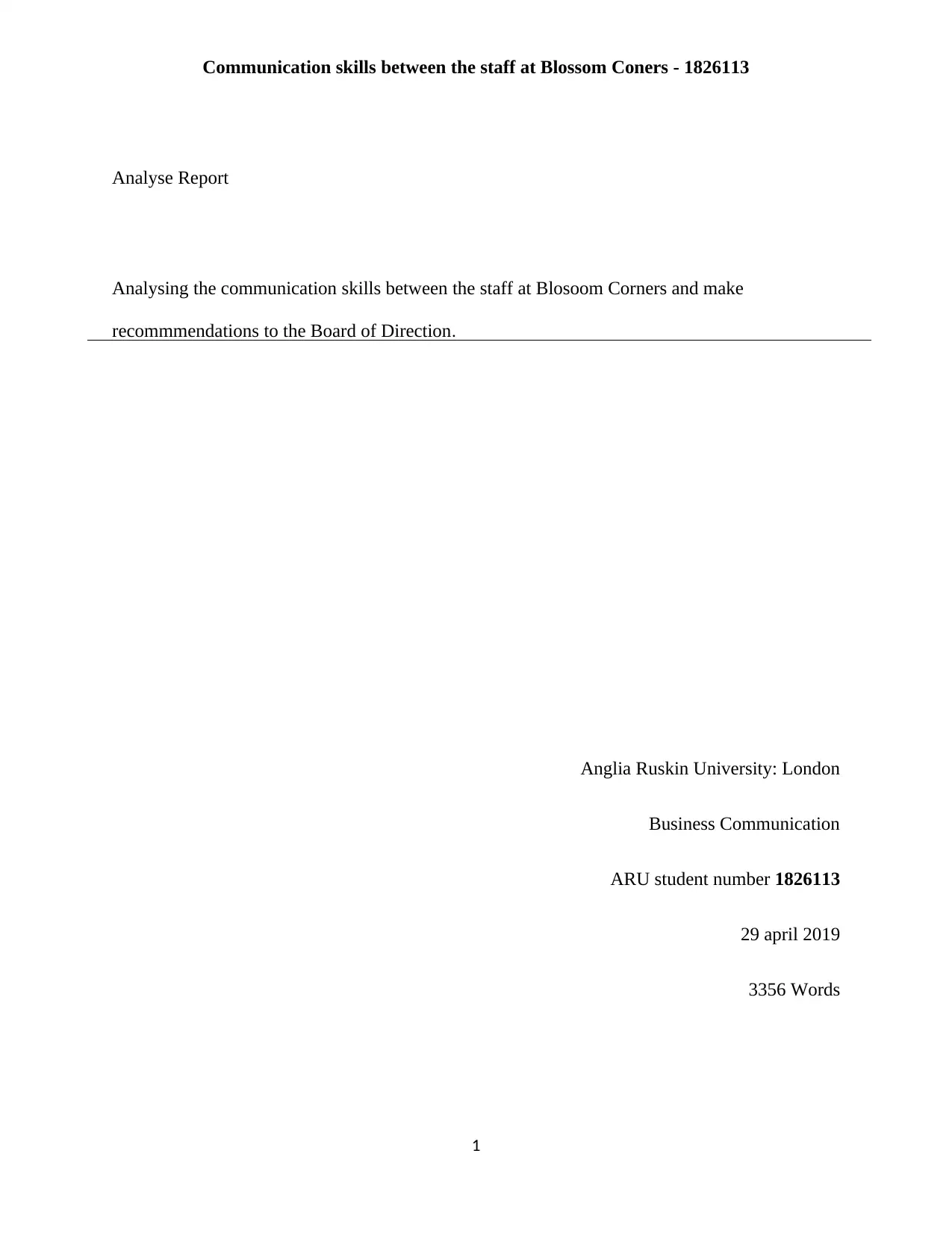
Communication skills between the staff at Blossom Coners - 1826113
Analyse Report
Analysing the communication skills between the staff at Blosoom Corners and make
recommmendations to the Board of Direction.
Anglia Ruskin University: London
Business Communication
ARU student number 1826113
29 april 2019
3356 Words
1
Analyse Report
Analysing the communication skills between the staff at Blosoom Corners and make
recommmendations to the Board of Direction.
Anglia Ruskin University: London
Business Communication
ARU student number 1826113
29 april 2019
3356 Words
1
Paraphrase This Document
Need a fresh take? Get an instant paraphrase of this document with our AI Paraphraser
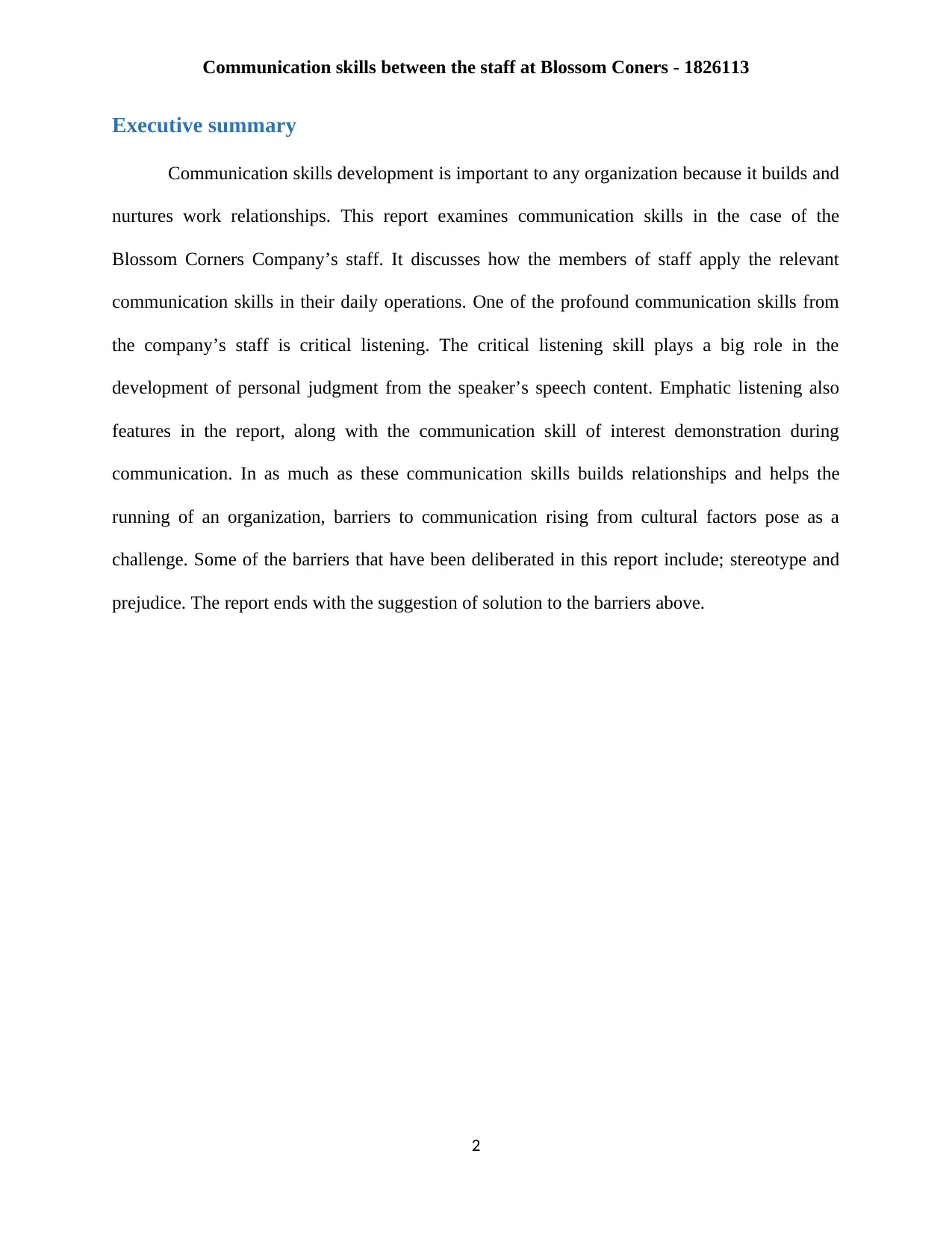
Communication skills between the staff at Blossom Coners - 1826113
Executive summary
Communication skills development is important to any organization because it builds and
nurtures work relationships. This report examines communication skills in the case of the
Blossom Corners Company’s staff. It discusses how the members of staff apply the relevant
communication skills in their daily operations. One of the profound communication skills from
the company’s staff is critical listening. The critical listening skill plays a big role in the
development of personal judgment from the speaker’s speech content. Emphatic listening also
features in the report, along with the communication skill of interest demonstration during
communication. In as much as these communication skills builds relationships and helps the
running of an organization, barriers to communication rising from cultural factors pose as a
challenge. Some of the barriers that have been deliberated in this report include; stereotype and
prejudice. The report ends with the suggestion of solution to the barriers above.
2
Executive summary
Communication skills development is important to any organization because it builds and
nurtures work relationships. This report examines communication skills in the case of the
Blossom Corners Company’s staff. It discusses how the members of staff apply the relevant
communication skills in their daily operations. One of the profound communication skills from
the company’s staff is critical listening. The critical listening skill plays a big role in the
development of personal judgment from the speaker’s speech content. Emphatic listening also
features in the report, along with the communication skill of interest demonstration during
communication. In as much as these communication skills builds relationships and helps the
running of an organization, barriers to communication rising from cultural factors pose as a
challenge. Some of the barriers that have been deliberated in this report include; stereotype and
prejudice. The report ends with the suggestion of solution to the barriers above.
2
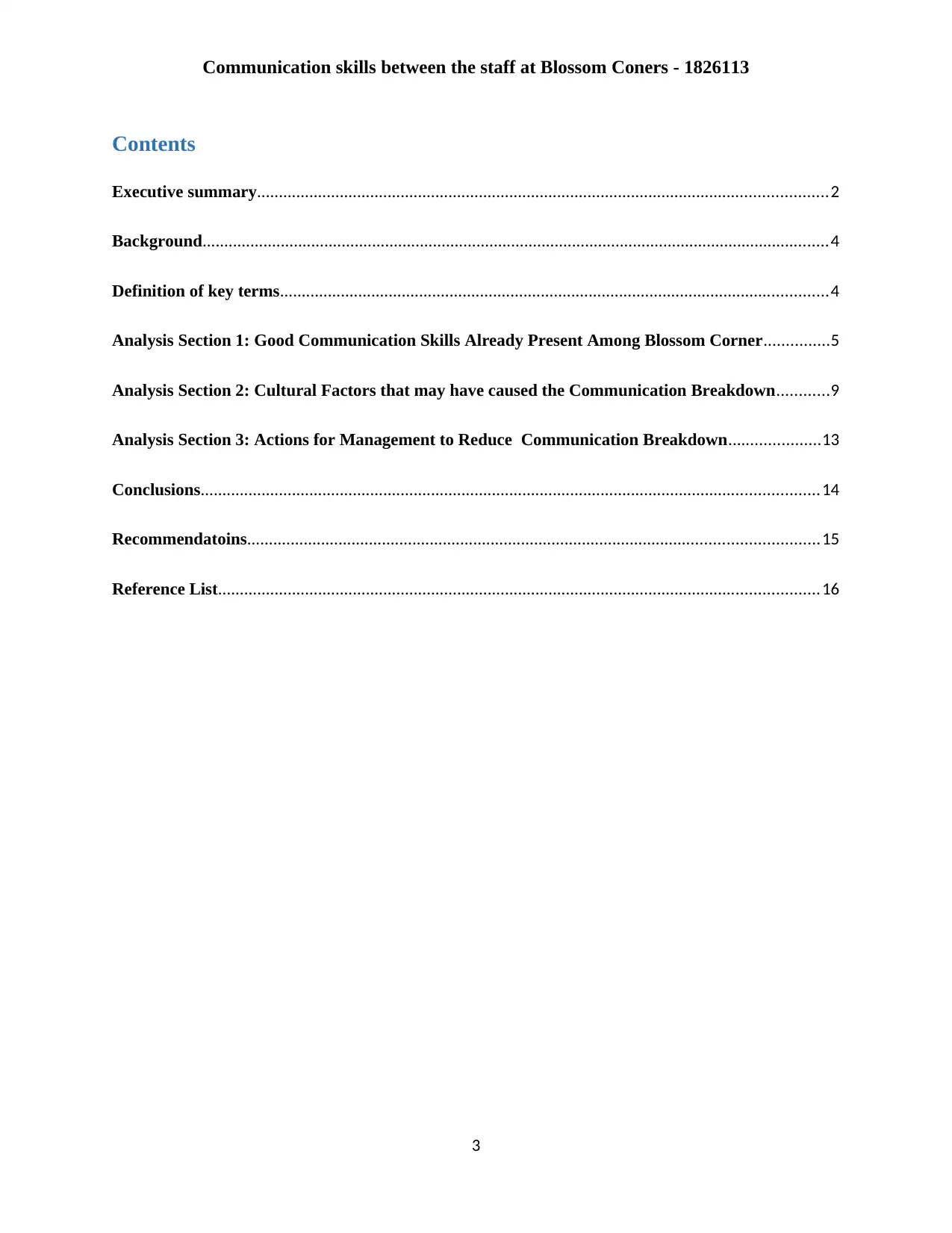
Communication skills between the staff at Blossom Coners - 1826113
Contents
Executive summary...................................................................................................................................2
Background................................................................................................................................................4
Definition of key terms..............................................................................................................................4
Analysis Section 1: Good Communication Skills Already Present Among Blossom Corner...............5
Analysis Section 2: Cultural Factors that may have caused the Communication Breakdown............9
Analysis Section 3: Actions for Management to Reduce Communication Breakdown.....................13
Conclusions..............................................................................................................................................14
Recommendatoins...................................................................................................................................15
Reference List..........................................................................................................................................16
3
Contents
Executive summary...................................................................................................................................2
Background................................................................................................................................................4
Definition of key terms..............................................................................................................................4
Analysis Section 1: Good Communication Skills Already Present Among Blossom Corner...............5
Analysis Section 2: Cultural Factors that may have caused the Communication Breakdown............9
Analysis Section 3: Actions for Management to Reduce Communication Breakdown.....................13
Conclusions..............................................................................................................................................14
Recommendatoins...................................................................................................................................15
Reference List..........................................................................................................................................16
3
⊘ This is a preview!⊘
Do you want full access?
Subscribe today to unlock all pages.

Trusted by 1+ million students worldwide
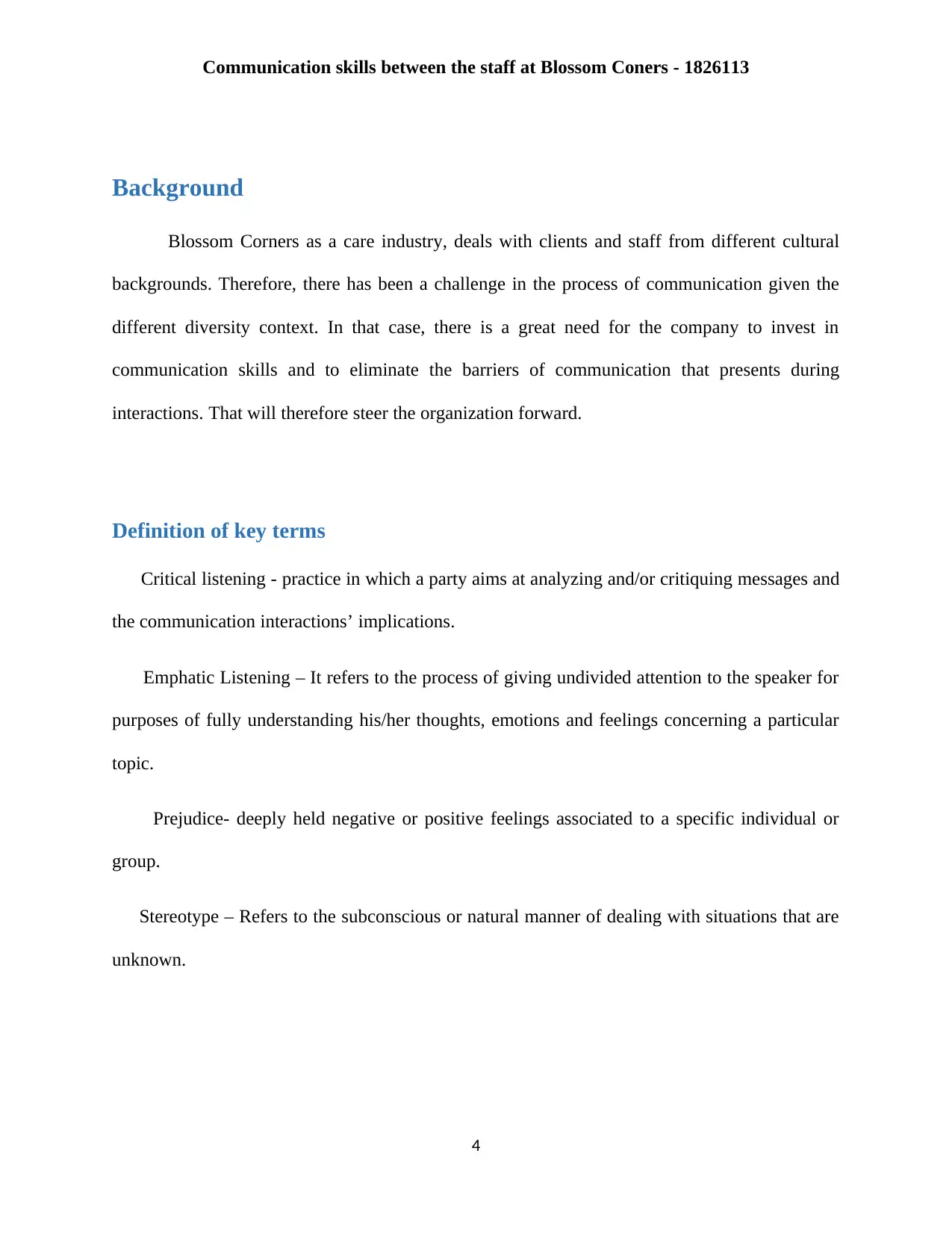
Communication skills between the staff at Blossom Coners - 1826113
Background
Blossom Corners as a care industry, deals with clients and staff from different cultural
backgrounds. Therefore, there has been a challenge in the process of communication given the
different diversity context. In that case, there is a great need for the company to invest in
communication skills and to eliminate the barriers of communication that presents during
interactions. That will therefore steer the organization forward.
Definition of key terms
Critical listening - practice in which a party aims at analyzing and/or critiquing messages and
the communication interactions’ implications.
Emphatic Listening – It refers to the process of giving undivided attention to the speaker for
purposes of fully understanding his/her thoughts, emotions and feelings concerning a particular
topic.
Prejudice- deeply held negative or positive feelings associated to a specific individual or
group.
Stereotype – Refers to the subconscious or natural manner of dealing with situations that are
unknown.
4
Background
Blossom Corners as a care industry, deals with clients and staff from different cultural
backgrounds. Therefore, there has been a challenge in the process of communication given the
different diversity context. In that case, there is a great need for the company to invest in
communication skills and to eliminate the barriers of communication that presents during
interactions. That will therefore steer the organization forward.
Definition of key terms
Critical listening - practice in which a party aims at analyzing and/or critiquing messages and
the communication interactions’ implications.
Emphatic Listening – It refers to the process of giving undivided attention to the speaker for
purposes of fully understanding his/her thoughts, emotions and feelings concerning a particular
topic.
Prejudice- deeply held negative or positive feelings associated to a specific individual or
group.
Stereotype – Refers to the subconscious or natural manner of dealing with situations that are
unknown.
4
Paraphrase This Document
Need a fresh take? Get an instant paraphrase of this document with our AI Paraphraser
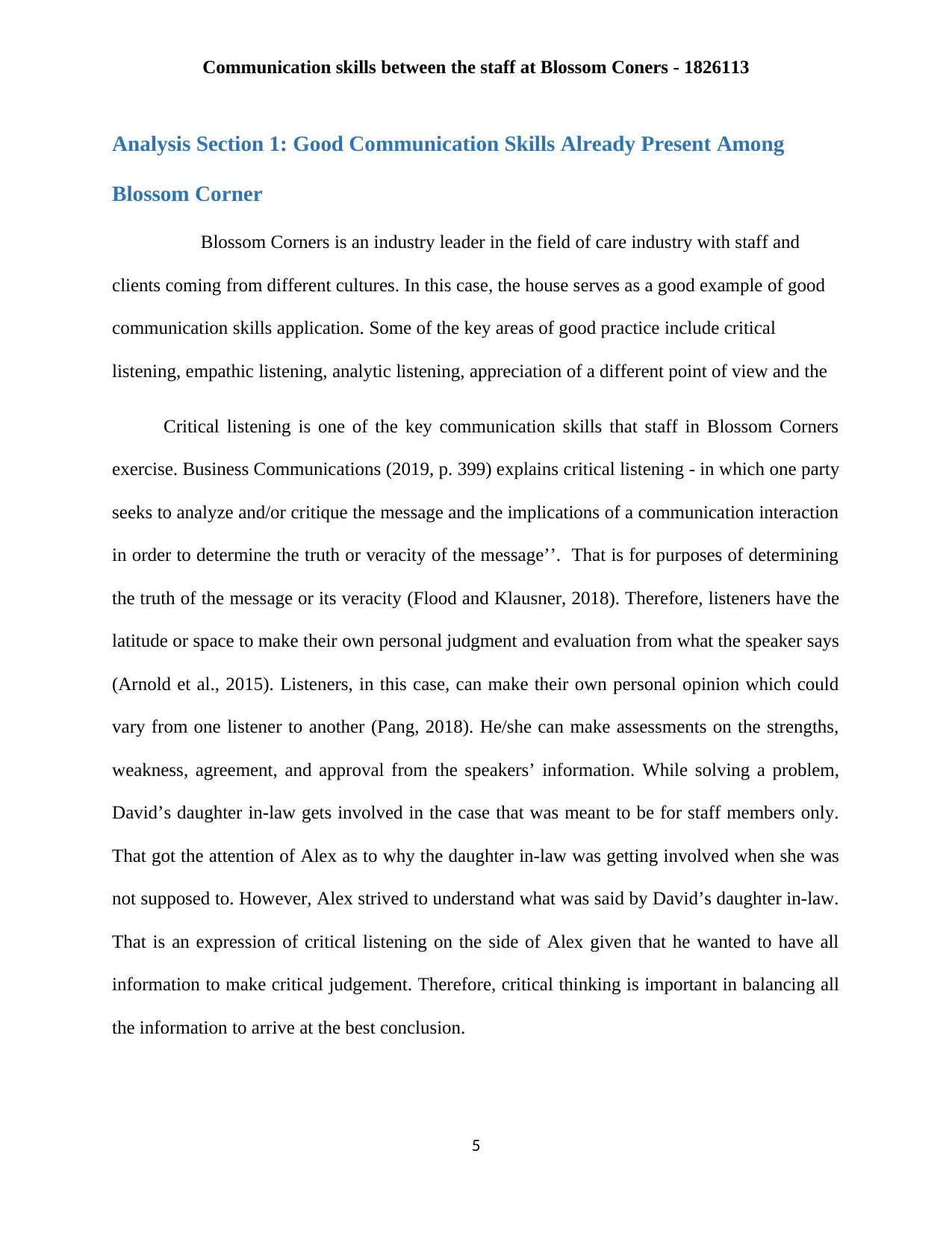
Communication skills between the staff at Blossom Coners - 1826113
Analysis Section 1: Good Communication Skills Already Present Among
Blossom Corner
Blossom Corners is an industry leader in the field of care industry with staff and
clients coming from different cultures. In this case, the house serves as a good example of good
communication skills application. Some of the key areas of good practice include critical
listening, empathic listening, analytic listening, appreciation of a different point of view and the
Critical listening is one of the key communication skills that staff in Blossom Corners
exercise. Business Communications (2019, p. 399) explains critical listening - in which one party
seeks to analyze and/or critique the message and the implications of a communication interaction
in order to determine the truth or veracity of the message’’. That is for purposes of determining
the truth of the message or its veracity (Flood and Klausner, 2018). Therefore, listeners have the
latitude or space to make their own personal judgment and evaluation from what the speaker says
(Arnold et al., 2015). Listeners, in this case, can make their own personal opinion which could
vary from one listener to another (Pang, 2018). He/she can make assessments on the strengths,
weakness, agreement, and approval from the speakers’ information. While solving a problem,
David’s daughter in-law gets involved in the case that was meant to be for staff members only.
That got the attention of Alex as to why the daughter in-law was getting involved when she was
not supposed to. However, Alex strived to understand what was said by David’s daughter in-law.
That is an expression of critical listening on the side of Alex given that he wanted to have all
information to make critical judgement. Therefore, critical thinking is important in balancing all
the information to arrive at the best conclusion.
5
Analysis Section 1: Good Communication Skills Already Present Among
Blossom Corner
Blossom Corners is an industry leader in the field of care industry with staff and
clients coming from different cultures. In this case, the house serves as a good example of good
communication skills application. Some of the key areas of good practice include critical
listening, empathic listening, analytic listening, appreciation of a different point of view and the
Critical listening is one of the key communication skills that staff in Blossom Corners
exercise. Business Communications (2019, p. 399) explains critical listening - in which one party
seeks to analyze and/or critique the message and the implications of a communication interaction
in order to determine the truth or veracity of the message’’. That is for purposes of determining
the truth of the message or its veracity (Flood and Klausner, 2018). Therefore, listeners have the
latitude or space to make their own personal judgment and evaluation from what the speaker says
(Arnold et al., 2015). Listeners, in this case, can make their own personal opinion which could
vary from one listener to another (Pang, 2018). He/she can make assessments on the strengths,
weakness, agreement, and approval from the speakers’ information. While solving a problem,
David’s daughter in-law gets involved in the case that was meant to be for staff members only.
That got the attention of Alex as to why the daughter in-law was getting involved when she was
not supposed to. However, Alex strived to understand what was said by David’s daughter in-law.
That is an expression of critical listening on the side of Alex given that he wanted to have all
information to make critical judgement. Therefore, critical thinking is important in balancing all
the information to arrive at the best conclusion.
5
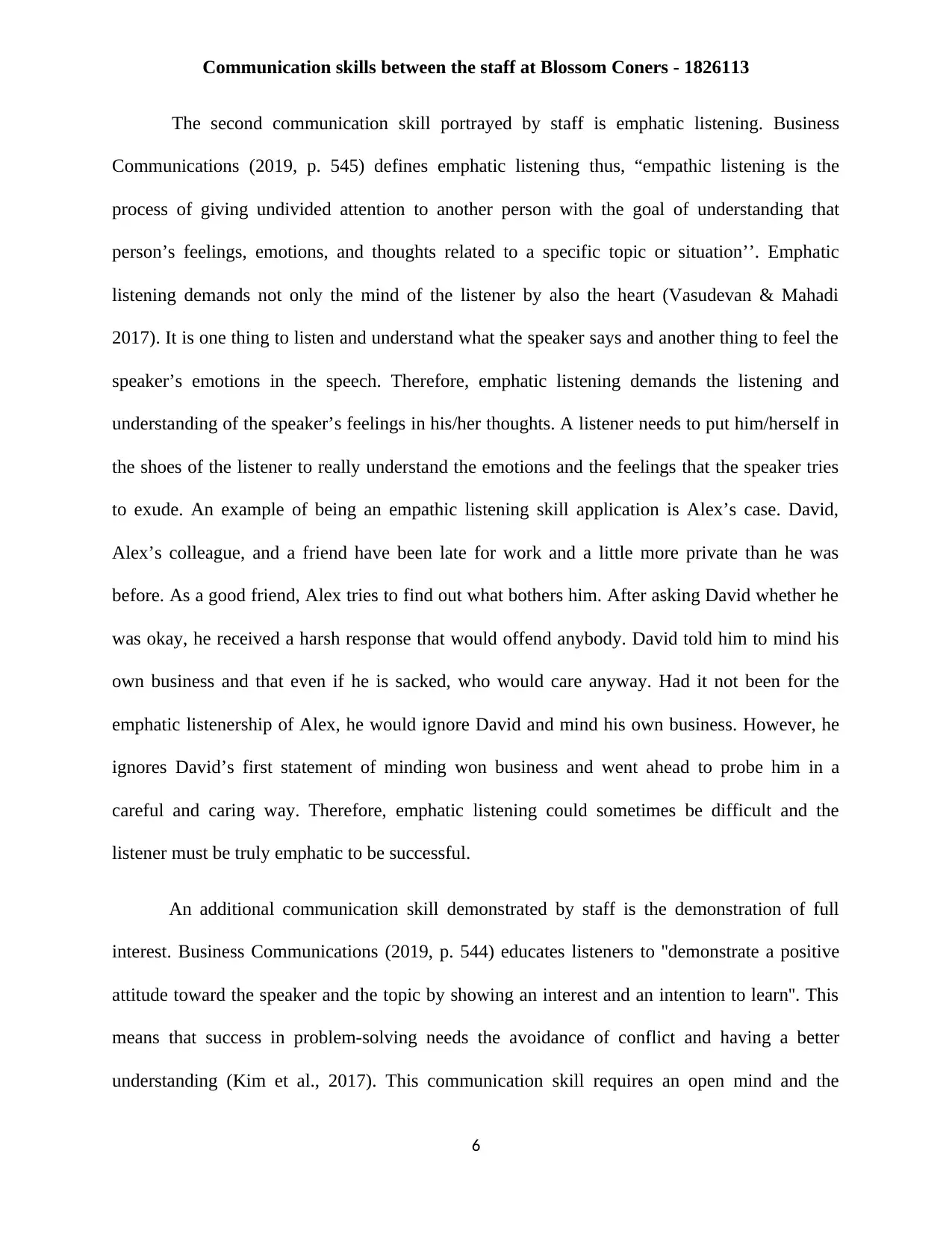
Communication skills between the staff at Blossom Coners - 1826113
The second communication skill portrayed by staff is emphatic listening. Business
Communications (2019, p. 545) defines emphatic listening thus, “empathic listening is the
process of giving undivided attention to another person with the goal of understanding that
person’s feelings, emotions, and thoughts related to a specific topic or situation’’. Emphatic
listening demands not only the mind of the listener by also the heart (Vasudevan & Mahadi
2017). It is one thing to listen and understand what the speaker says and another thing to feel the
speaker’s emotions in the speech. Therefore, emphatic listening demands the listening and
understanding of the speaker’s feelings in his/her thoughts. A listener needs to put him/herself in
the shoes of the listener to really understand the emotions and the feelings that the speaker tries
to exude. An example of being an empathic listening skill application is Alex’s case. David,
Alex’s colleague, and a friend have been late for work and a little more private than he was
before. As a good friend, Alex tries to find out what bothers him. After asking David whether he
was okay, he received a harsh response that would offend anybody. David told him to mind his
own business and that even if he is sacked, who would care anyway. Had it not been for the
emphatic listenership of Alex, he would ignore David and mind his own business. However, he
ignores David’s first statement of minding won business and went ahead to probe him in a
careful and caring way. Therefore, emphatic listening could sometimes be difficult and the
listener must be truly emphatic to be successful.
An additional communication skill demonstrated by staff is the demonstration of full
interest. Business Communications (2019, p. 544) educates listeners to ''demonstrate a positive
attitude toward the speaker and the topic by showing an interest and an intention to learn''. This
means that success in problem-solving needs the avoidance of conflict and having a better
understanding (Kim et al., 2017). This communication skill requires an open mind and the
6
The second communication skill portrayed by staff is emphatic listening. Business
Communications (2019, p. 545) defines emphatic listening thus, “empathic listening is the
process of giving undivided attention to another person with the goal of understanding that
person’s feelings, emotions, and thoughts related to a specific topic or situation’’. Emphatic
listening demands not only the mind of the listener by also the heart (Vasudevan & Mahadi
2017). It is one thing to listen and understand what the speaker says and another thing to feel the
speaker’s emotions in the speech. Therefore, emphatic listening demands the listening and
understanding of the speaker’s feelings in his/her thoughts. A listener needs to put him/herself in
the shoes of the listener to really understand the emotions and the feelings that the speaker tries
to exude. An example of being an empathic listening skill application is Alex’s case. David,
Alex’s colleague, and a friend have been late for work and a little more private than he was
before. As a good friend, Alex tries to find out what bothers him. After asking David whether he
was okay, he received a harsh response that would offend anybody. David told him to mind his
own business and that even if he is sacked, who would care anyway. Had it not been for the
emphatic listenership of Alex, he would ignore David and mind his own business. However, he
ignores David’s first statement of minding won business and went ahead to probe him in a
careful and caring way. Therefore, emphatic listening could sometimes be difficult and the
listener must be truly emphatic to be successful.
An additional communication skill demonstrated by staff is the demonstration of full
interest. Business Communications (2019, p. 544) educates listeners to ''demonstrate a positive
attitude toward the speaker and the topic by showing an interest and an intention to learn''. This
means that success in problem-solving needs the avoidance of conflict and having a better
understanding (Kim et al., 2017). This communication skill requires an open mind and the
6
⊘ This is a preview!⊘
Do you want full access?
Subscribe today to unlock all pages.

Trusted by 1+ million students worldwide
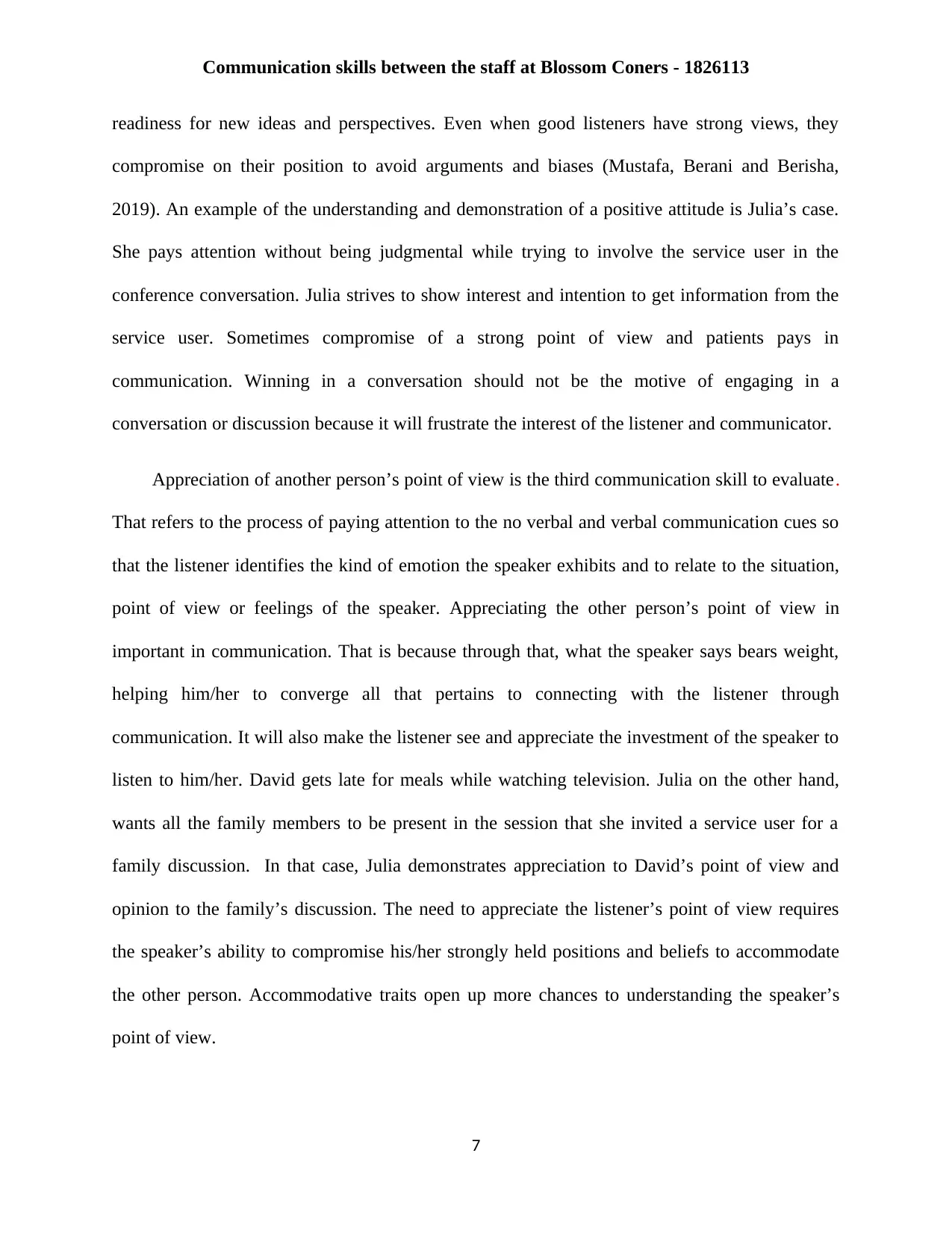
Communication skills between the staff at Blossom Coners - 1826113
readiness for new ideas and perspectives. Even when good listeners have strong views, they
compromise on their position to avoid arguments and biases (Mustafa, Berani and Berisha,
2019). An example of the understanding and demonstration of a positive attitude is Julia’s case.
She pays attention without being judgmental while trying to involve the service user in the
conference conversation. Julia strives to show interest and intention to get information from the
service user. Sometimes compromise of a strong point of view and patients pays in
communication. Winning in a conversation should not be the motive of engaging in a
conversation or discussion because it will frustrate the interest of the listener and communicator.
Appreciation of another person’s point of view is the third communication skill to evaluate.
That refers to the process of paying attention to the no verbal and verbal communication cues so
that the listener identifies the kind of emotion the speaker exhibits and to relate to the situation,
point of view or feelings of the speaker. Appreciating the other person’s point of view in
important in communication. That is because through that, what the speaker says bears weight,
helping him/her to converge all that pertains to connecting with the listener through
communication. It will also make the listener see and appreciate the investment of the speaker to
listen to him/her. David gets late for meals while watching television. Julia on the other hand,
wants all the family members to be present in the session that she invited a service user for a
family discussion. In that case, Julia demonstrates appreciation to David’s point of view and
opinion to the family’s discussion. The need to appreciate the listener’s point of view requires
the speaker’s ability to compromise his/her strongly held positions and beliefs to accommodate
the other person. Accommodative traits open up more chances to understanding the speaker’s
point of view.
7
readiness for new ideas and perspectives. Even when good listeners have strong views, they
compromise on their position to avoid arguments and biases (Mustafa, Berani and Berisha,
2019). An example of the understanding and demonstration of a positive attitude is Julia’s case.
She pays attention without being judgmental while trying to involve the service user in the
conference conversation. Julia strives to show interest and intention to get information from the
service user. Sometimes compromise of a strong point of view and patients pays in
communication. Winning in a conversation should not be the motive of engaging in a
conversation or discussion because it will frustrate the interest of the listener and communicator.
Appreciation of another person’s point of view is the third communication skill to evaluate.
That refers to the process of paying attention to the no verbal and verbal communication cues so
that the listener identifies the kind of emotion the speaker exhibits and to relate to the situation,
point of view or feelings of the speaker. Appreciating the other person’s point of view in
important in communication. That is because through that, what the speaker says bears weight,
helping him/her to converge all that pertains to connecting with the listener through
communication. It will also make the listener see and appreciate the investment of the speaker to
listen to him/her. David gets late for meals while watching television. Julia on the other hand,
wants all the family members to be present in the session that she invited a service user for a
family discussion. In that case, Julia demonstrates appreciation to David’s point of view and
opinion to the family’s discussion. The need to appreciate the listener’s point of view requires
the speaker’s ability to compromise his/her strongly held positions and beliefs to accommodate
the other person. Accommodative traits open up more chances to understanding the speaker’s
point of view.
7
Paraphrase This Document
Need a fresh take? Get an instant paraphrase of this document with our AI Paraphraser
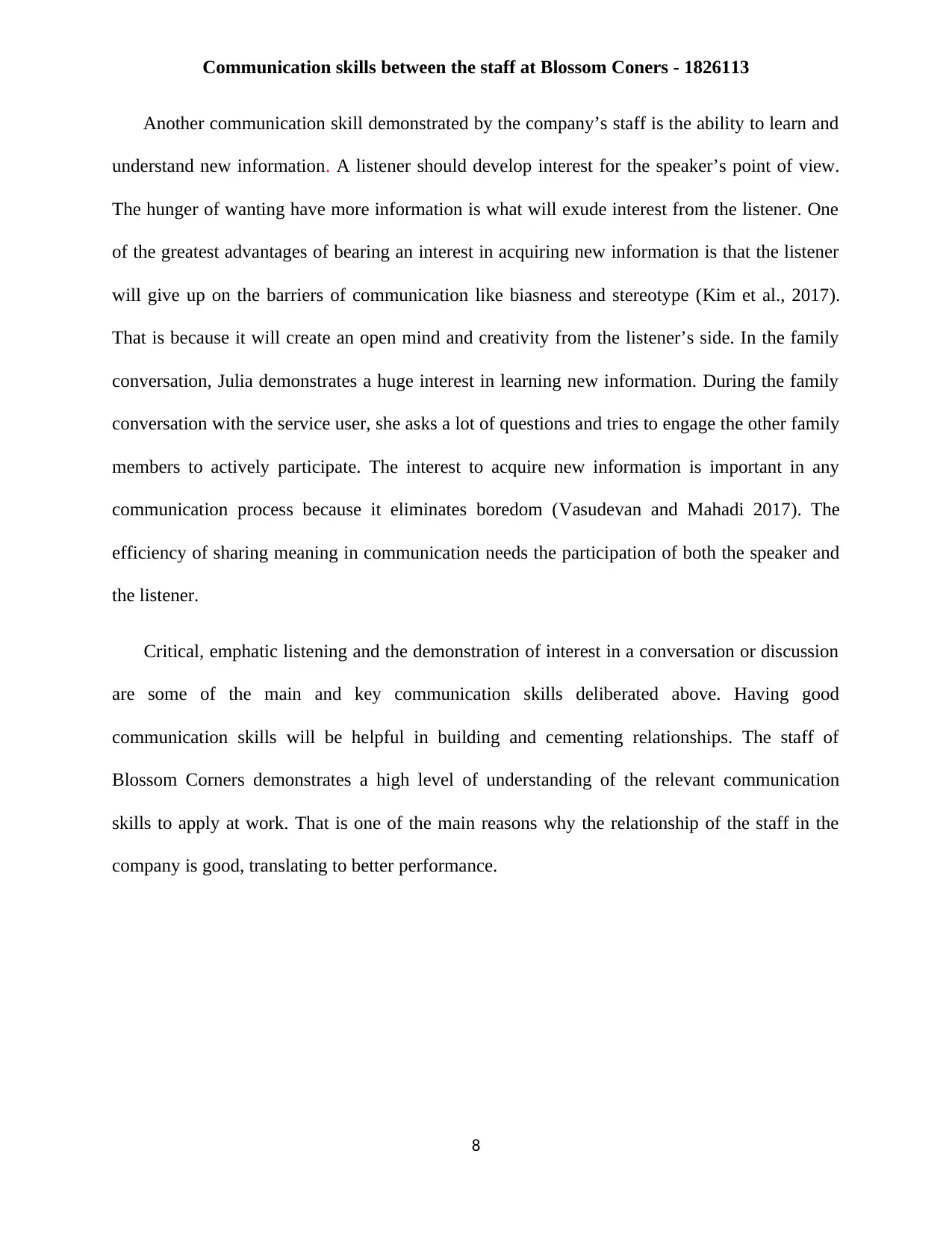
Communication skills between the staff at Blossom Coners - 1826113
Another communication skill demonstrated by the company’s staff is the ability to learn and
understand new information. A listener should develop interest for the speaker’s point of view.
The hunger of wanting have more information is what will exude interest from the listener. One
of the greatest advantages of bearing an interest in acquiring new information is that the listener
will give up on the barriers of communication like biasness and stereotype (Kim et al., 2017).
That is because it will create an open mind and creativity from the listener’s side. In the family
conversation, Julia demonstrates a huge interest in learning new information. During the family
conversation with the service user, she asks a lot of questions and tries to engage the other family
members to actively participate. The interest to acquire new information is important in any
communication process because it eliminates boredom (Vasudevan and Mahadi 2017). The
efficiency of sharing meaning in communication needs the participation of both the speaker and
the listener.
Critical, emphatic listening and the demonstration of interest in a conversation or discussion
are some of the main and key communication skills deliberated above. Having good
communication skills will be helpful in building and cementing relationships. The staff of
Blossom Corners demonstrates a high level of understanding of the relevant communication
skills to apply at work. That is one of the main reasons why the relationship of the staff in the
company is good, translating to better performance.
8
Another communication skill demonstrated by the company’s staff is the ability to learn and
understand new information. A listener should develop interest for the speaker’s point of view.
The hunger of wanting have more information is what will exude interest from the listener. One
of the greatest advantages of bearing an interest in acquiring new information is that the listener
will give up on the barriers of communication like biasness and stereotype (Kim et al., 2017).
That is because it will create an open mind and creativity from the listener’s side. In the family
conversation, Julia demonstrates a huge interest in learning new information. During the family
conversation with the service user, she asks a lot of questions and tries to engage the other family
members to actively participate. The interest to acquire new information is important in any
communication process because it eliminates boredom (Vasudevan and Mahadi 2017). The
efficiency of sharing meaning in communication needs the participation of both the speaker and
the listener.
Critical, emphatic listening and the demonstration of interest in a conversation or discussion
are some of the main and key communication skills deliberated above. Having good
communication skills will be helpful in building and cementing relationships. The staff of
Blossom Corners demonstrates a high level of understanding of the relevant communication
skills to apply at work. That is one of the main reasons why the relationship of the staff in the
company is good, translating to better performance.
8
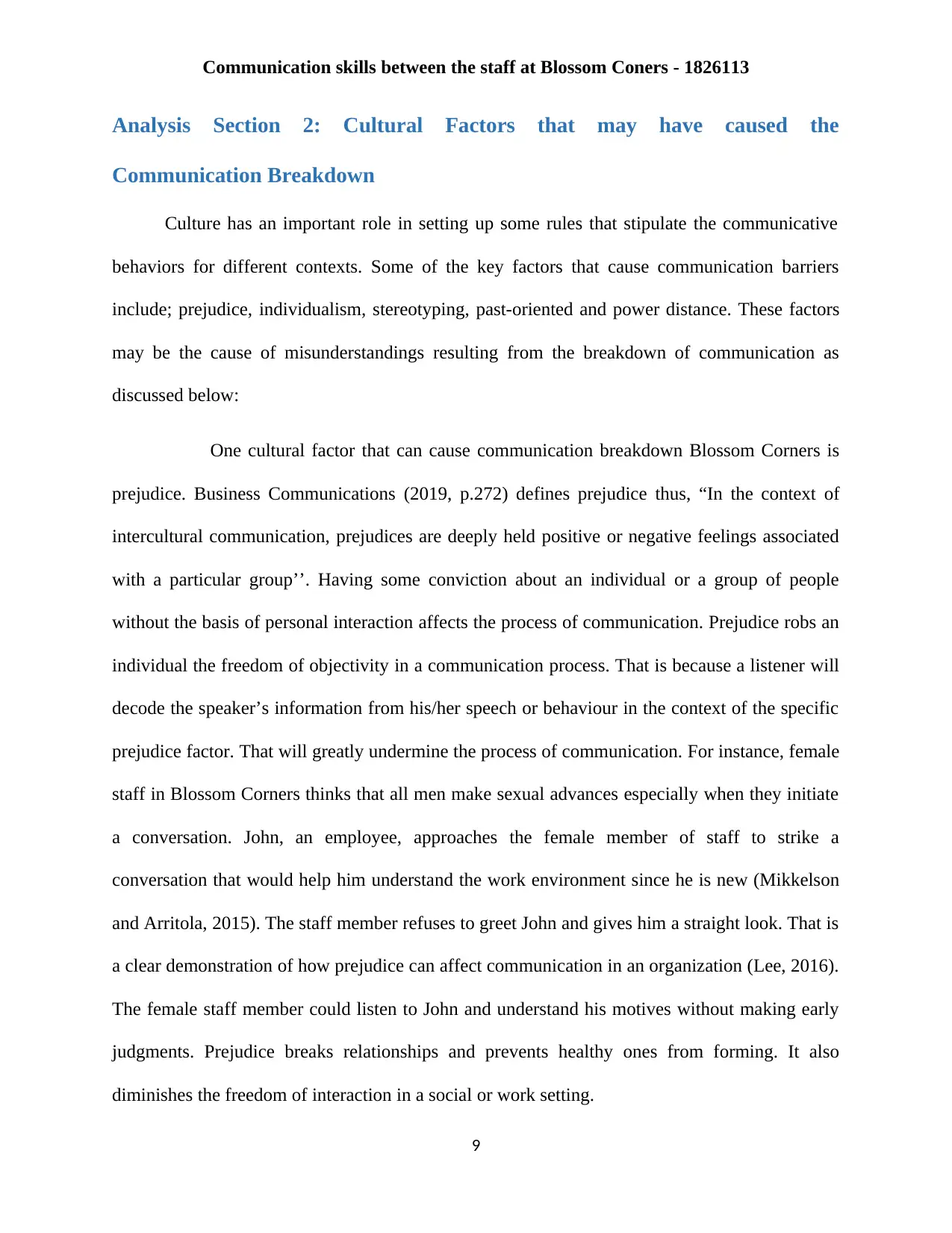
Communication skills between the staff at Blossom Coners - 1826113
Analysis Section 2: Cultural Factors that may have caused the
Communication Breakdown
Culture has an important role in setting up some rules that stipulate the communicative
behaviors for different contexts. Some of the key factors that cause communication barriers
include; prejudice, individualism, stereotyping, past-oriented and power distance. These factors
may be the cause of misunderstandings resulting from the breakdown of communication as
discussed below:
One cultural factor that can cause communication breakdown Blossom Corners is
prejudice. Business Communications (2019, p.272) defines prejudice thus, “In the context of
intercultural communication, prejudices are deeply held positive or negative feelings associated
with a particular group’’. Having some conviction about an individual or a group of people
without the basis of personal interaction affects the process of communication. Prejudice robs an
individual the freedom of objectivity in a communication process. That is because a listener will
decode the speaker’s information from his/her speech or behaviour in the context of the specific
prejudice factor. That will greatly undermine the process of communication. For instance, female
staff in Blossom Corners thinks that all men make sexual advances especially when they initiate
a conversation. John, an employee, approaches the female member of staff to strike a
conversation that would help him understand the work environment since he is new (Mikkelson
and Arritola, 2015). The staff member refuses to greet John and gives him a straight look. That is
a clear demonstration of how prejudice can affect communication in an organization (Lee, 2016).
The female staff member could listen to John and understand his motives without making early
judgments. Prejudice breaks relationships and prevents healthy ones from forming. It also
diminishes the freedom of interaction in a social or work setting.
9
Analysis Section 2: Cultural Factors that may have caused the
Communication Breakdown
Culture has an important role in setting up some rules that stipulate the communicative
behaviors for different contexts. Some of the key factors that cause communication barriers
include; prejudice, individualism, stereotyping, past-oriented and power distance. These factors
may be the cause of misunderstandings resulting from the breakdown of communication as
discussed below:
One cultural factor that can cause communication breakdown Blossom Corners is
prejudice. Business Communications (2019, p.272) defines prejudice thus, “In the context of
intercultural communication, prejudices are deeply held positive or negative feelings associated
with a particular group’’. Having some conviction about an individual or a group of people
without the basis of personal interaction affects the process of communication. Prejudice robs an
individual the freedom of objectivity in a communication process. That is because a listener will
decode the speaker’s information from his/her speech or behaviour in the context of the specific
prejudice factor. That will greatly undermine the process of communication. For instance, female
staff in Blossom Corners thinks that all men make sexual advances especially when they initiate
a conversation. John, an employee, approaches the female member of staff to strike a
conversation that would help him understand the work environment since he is new (Mikkelson
and Arritola, 2015). The staff member refuses to greet John and gives him a straight look. That is
a clear demonstration of how prejudice can affect communication in an organization (Lee, 2016).
The female staff member could listen to John and understand his motives without making early
judgments. Prejudice breaks relationships and prevents healthy ones from forming. It also
diminishes the freedom of interaction in a social or work setting.
9
⊘ This is a preview!⊘
Do you want full access?
Subscribe today to unlock all pages.

Trusted by 1+ million students worldwide
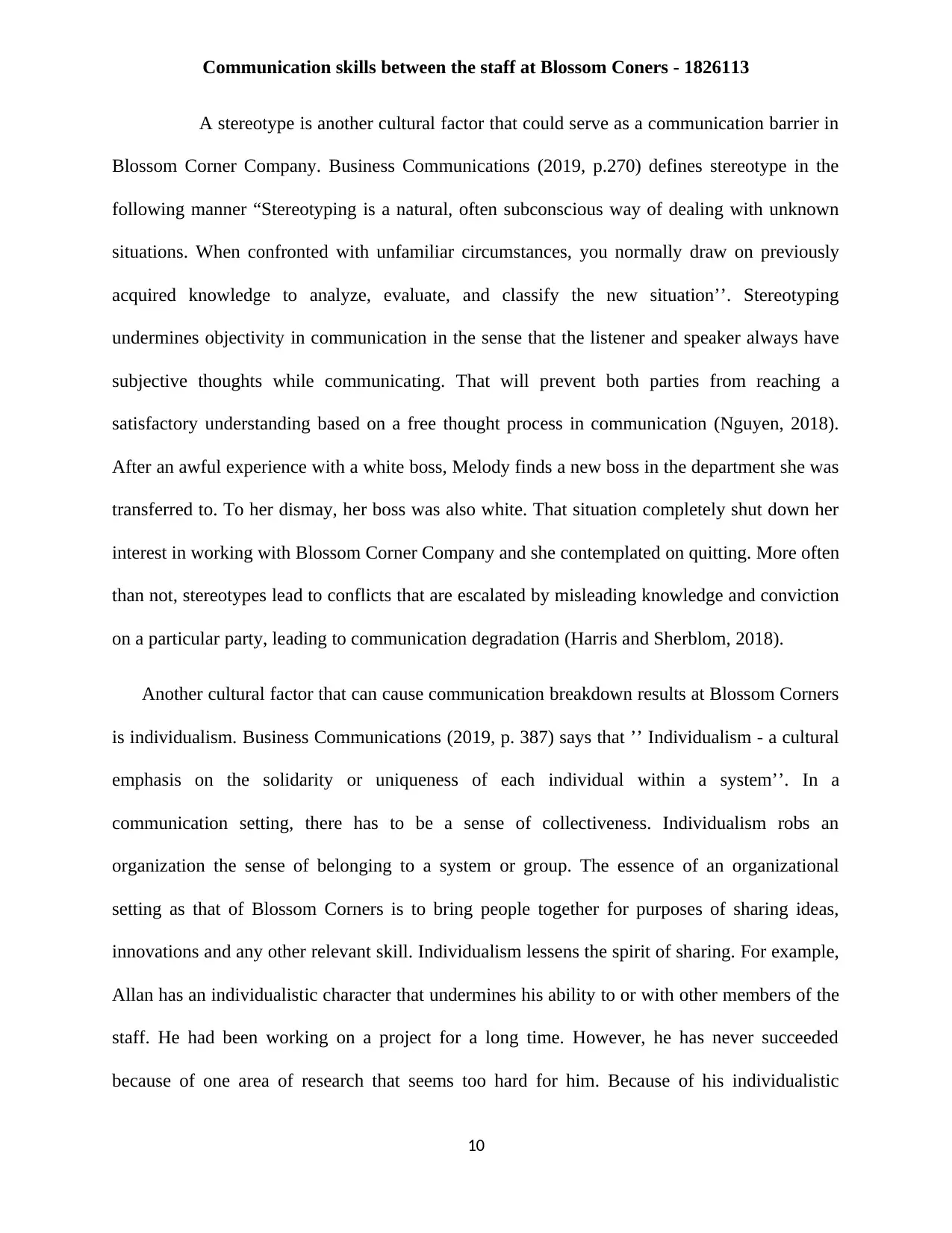
Communication skills between the staff at Blossom Coners - 1826113
A stereotype is another cultural factor that could serve as a communication barrier in
Blossom Corner Company. Business Communications (2019, p.270) defines stereotype in the
following manner “Stereotyping is a natural, often subconscious way of dealing with unknown
situations. When confronted with unfamiliar circumstances, you normally draw on previously
acquired knowledge to analyze, evaluate, and classify the new situation’’. Stereotyping
undermines objectivity in communication in the sense that the listener and speaker always have
subjective thoughts while communicating. That will prevent both parties from reaching a
satisfactory understanding based on a free thought process in communication (Nguyen, 2018).
After an awful experience with a white boss, Melody finds a new boss in the department she was
transferred to. To her dismay, her boss was also white. That situation completely shut down her
interest in working with Blossom Corner Company and she contemplated on quitting. More often
than not, stereotypes lead to conflicts that are escalated by misleading knowledge and conviction
on a particular party, leading to communication degradation (Harris and Sherblom, 2018).
Another cultural factor that can cause communication breakdown results at Blossom Corners
is individualism. Business Communications (2019, p. 387) says that ’’ Individualism - a cultural
emphasis on the solidarity or uniqueness of each individual within a system’’. In a
communication setting, there has to be a sense of collectiveness. Individualism robs an
organization the sense of belonging to a system or group. The essence of an organizational
setting as that of Blossom Corners is to bring people together for purposes of sharing ideas,
innovations and any other relevant skill. Individualism lessens the spirit of sharing. For example,
Allan has an individualistic character that undermines his ability to or with other members of the
staff. He had been working on a project for a long time. However, he has never succeeded
because of one area of research that seems too hard for him. Because of his individualistic
10
A stereotype is another cultural factor that could serve as a communication barrier in
Blossom Corner Company. Business Communications (2019, p.270) defines stereotype in the
following manner “Stereotyping is a natural, often subconscious way of dealing with unknown
situations. When confronted with unfamiliar circumstances, you normally draw on previously
acquired knowledge to analyze, evaluate, and classify the new situation’’. Stereotyping
undermines objectivity in communication in the sense that the listener and speaker always have
subjective thoughts while communicating. That will prevent both parties from reaching a
satisfactory understanding based on a free thought process in communication (Nguyen, 2018).
After an awful experience with a white boss, Melody finds a new boss in the department she was
transferred to. To her dismay, her boss was also white. That situation completely shut down her
interest in working with Blossom Corner Company and she contemplated on quitting. More often
than not, stereotypes lead to conflicts that are escalated by misleading knowledge and conviction
on a particular party, leading to communication degradation (Harris and Sherblom, 2018).
Another cultural factor that can cause communication breakdown results at Blossom Corners
is individualism. Business Communications (2019, p. 387) says that ’’ Individualism - a cultural
emphasis on the solidarity or uniqueness of each individual within a system’’. In a
communication setting, there has to be a sense of collectiveness. Individualism robs an
organization the sense of belonging to a system or group. The essence of an organizational
setting as that of Blossom Corners is to bring people together for purposes of sharing ideas,
innovations and any other relevant skill. Individualism lessens the spirit of sharing. For example,
Allan has an individualistic character that undermines his ability to or with other members of the
staff. He had been working on a project for a long time. However, he has never succeeded
because of one area of research that seems too hard for him. Because of his individualistic
10
Paraphrase This Document
Need a fresh take? Get an instant paraphrase of this document with our AI Paraphraser
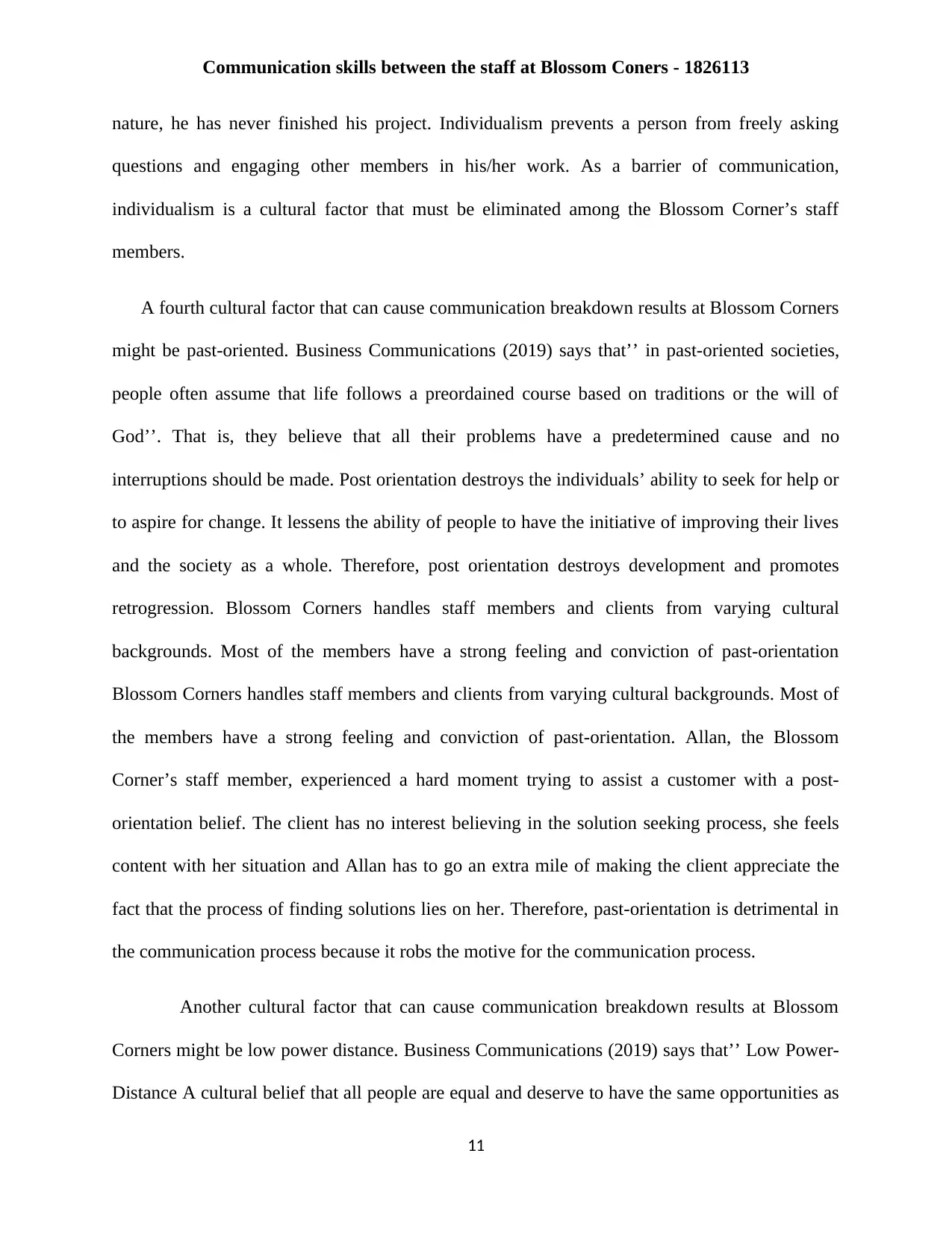
Communication skills between the staff at Blossom Coners - 1826113
nature, he has never finished his project. Individualism prevents a person from freely asking
questions and engaging other members in his/her work. As a barrier of communication,
individualism is a cultural factor that must be eliminated among the Blossom Corner’s staff
members.
A fourth cultural factor that can cause communication breakdown results at Blossom Corners
might be past-oriented. Business Communications (2019) says that’’ in past-oriented societies,
people often assume that life follows a preordained course based on traditions or the will of
God’’. That is, they believe that all their problems have a predetermined cause and no
interruptions should be made. Post orientation destroys the individuals’ ability to seek for help or
to aspire for change. It lessens the ability of people to have the initiative of improving their lives
and the society as a whole. Therefore, post orientation destroys development and promotes
retrogression. Blossom Corners handles staff members and clients from varying cultural
backgrounds. Most of the members have a strong feeling and conviction of past-orientation
Blossom Corners handles staff members and clients from varying cultural backgrounds. Most of
the members have a strong feeling and conviction of past-orientation. Allan, the Blossom
Corner’s staff member, experienced a hard moment trying to assist a customer with a post-
orientation belief. The client has no interest believing in the solution seeking process, she feels
content with her situation and Allan has to go an extra mile of making the client appreciate the
fact that the process of finding solutions lies on her. Therefore, past-orientation is detrimental in
the communication process because it robs the motive for the communication process.
Another cultural factor that can cause communication breakdown results at Blossom
Corners might be low power distance. Business Communications (2019) says that’’ Low Power-
Distance A cultural belief that all people are equal and deserve to have the same opportunities as
11
nature, he has never finished his project. Individualism prevents a person from freely asking
questions and engaging other members in his/her work. As a barrier of communication,
individualism is a cultural factor that must be eliminated among the Blossom Corner’s staff
members.
A fourth cultural factor that can cause communication breakdown results at Blossom Corners
might be past-oriented. Business Communications (2019) says that’’ in past-oriented societies,
people often assume that life follows a preordained course based on traditions or the will of
God’’. That is, they believe that all their problems have a predetermined cause and no
interruptions should be made. Post orientation destroys the individuals’ ability to seek for help or
to aspire for change. It lessens the ability of people to have the initiative of improving their lives
and the society as a whole. Therefore, post orientation destroys development and promotes
retrogression. Blossom Corners handles staff members and clients from varying cultural
backgrounds. Most of the members have a strong feeling and conviction of past-orientation
Blossom Corners handles staff members and clients from varying cultural backgrounds. Most of
the members have a strong feeling and conviction of past-orientation. Allan, the Blossom
Corner’s staff member, experienced a hard moment trying to assist a customer with a post-
orientation belief. The client has no interest believing in the solution seeking process, she feels
content with her situation and Allan has to go an extra mile of making the client appreciate the
fact that the process of finding solutions lies on her. Therefore, past-orientation is detrimental in
the communication process because it robs the motive for the communication process.
Another cultural factor that can cause communication breakdown results at Blossom
Corners might be low power distance. Business Communications (2019) says that’’ Low Power-
Distance A cultural belief that all people are equal and deserve to have the same opportunities as
11
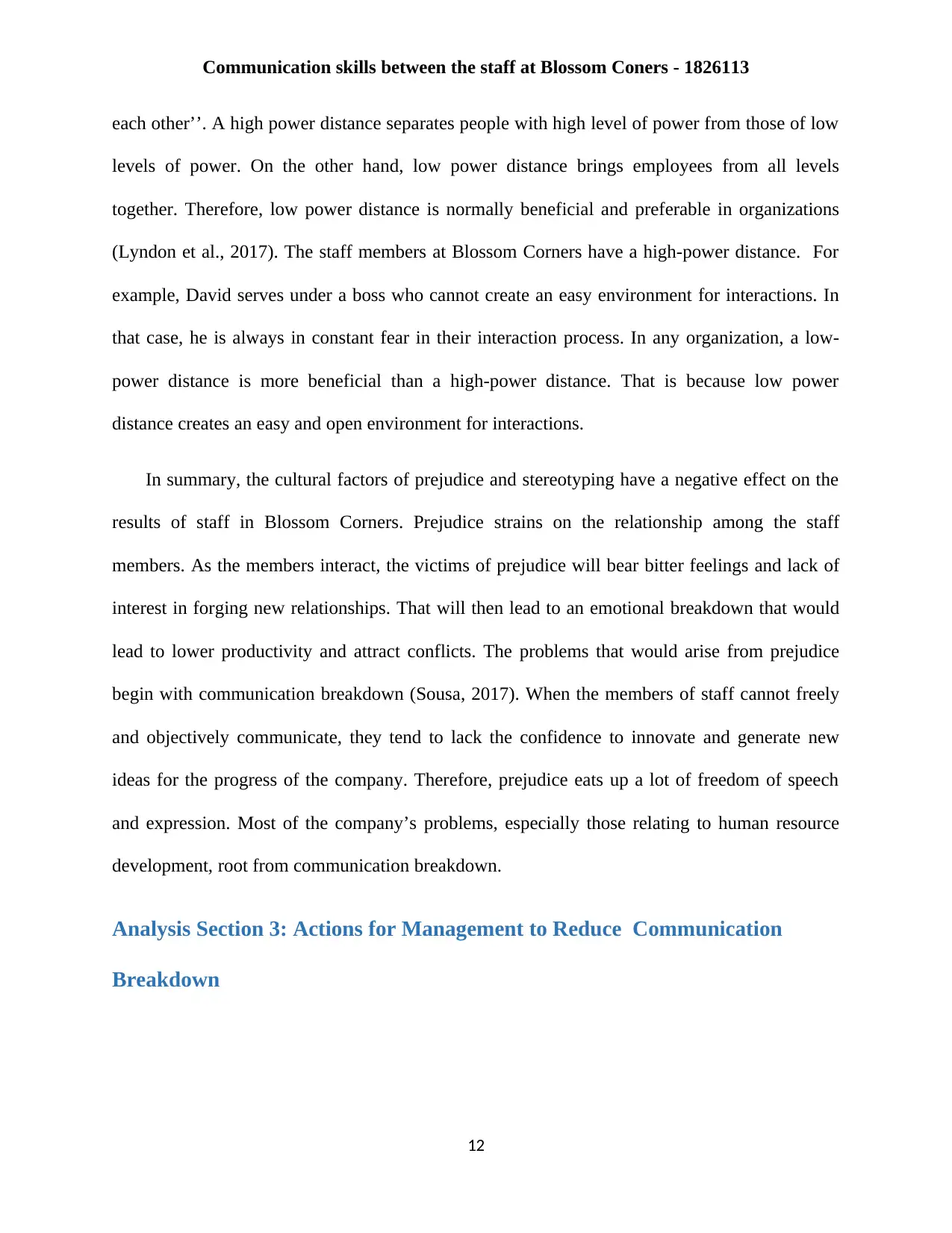
Communication skills between the staff at Blossom Coners - 1826113
each other’’. A high power distance separates people with high level of power from those of low
levels of power. On the other hand, low power distance brings employees from all levels
together. Therefore, low power distance is normally beneficial and preferable in organizations
(Lyndon et al., 2017). The staff members at Blossom Corners have a high-power distance. For
example, David serves under a boss who cannot create an easy environment for interactions. In
that case, he is always in constant fear in their interaction process. In any organization, a low-
power distance is more beneficial than a high-power distance. That is because low power
distance creates an easy and open environment for interactions.
In summary, the cultural factors of prejudice and stereotyping have a negative effect on the
results of staff in Blossom Corners. Prejudice strains on the relationship among the staff
members. As the members interact, the victims of prejudice will bear bitter feelings and lack of
interest in forging new relationships. That will then lead to an emotional breakdown that would
lead to lower productivity and attract conflicts. The problems that would arise from prejudice
begin with communication breakdown (Sousa, 2017). When the members of staff cannot freely
and objectively communicate, they tend to lack the confidence to innovate and generate new
ideas for the progress of the company. Therefore, prejudice eats up a lot of freedom of speech
and expression. Most of the company’s problems, especially those relating to human resource
development, root from communication breakdown.
Analysis Section 3: Actions for Management to Reduce Communication
Breakdown
12
each other’’. A high power distance separates people with high level of power from those of low
levels of power. On the other hand, low power distance brings employees from all levels
together. Therefore, low power distance is normally beneficial and preferable in organizations
(Lyndon et al., 2017). The staff members at Blossom Corners have a high-power distance. For
example, David serves under a boss who cannot create an easy environment for interactions. In
that case, he is always in constant fear in their interaction process. In any organization, a low-
power distance is more beneficial than a high-power distance. That is because low power
distance creates an easy and open environment for interactions.
In summary, the cultural factors of prejudice and stereotyping have a negative effect on the
results of staff in Blossom Corners. Prejudice strains on the relationship among the staff
members. As the members interact, the victims of prejudice will bear bitter feelings and lack of
interest in forging new relationships. That will then lead to an emotional breakdown that would
lead to lower productivity and attract conflicts. The problems that would arise from prejudice
begin with communication breakdown (Sousa, 2017). When the members of staff cannot freely
and objectively communicate, they tend to lack the confidence to innovate and generate new
ideas for the progress of the company. Therefore, prejudice eats up a lot of freedom of speech
and expression. Most of the company’s problems, especially those relating to human resource
development, root from communication breakdown.
Analysis Section 3: Actions for Management to Reduce Communication
Breakdown
12
⊘ This is a preview!⊘
Do you want full access?
Subscribe today to unlock all pages.

Trusted by 1+ million students worldwide
1 out of 16
Related Documents
Your All-in-One AI-Powered Toolkit for Academic Success.
+13062052269
info@desklib.com
Available 24*7 on WhatsApp / Email
![[object Object]](/_next/static/media/star-bottom.7253800d.svg)
Unlock your academic potential
Copyright © 2020–2025 A2Z Services. All Rights Reserved. Developed and managed by ZUCOL.


